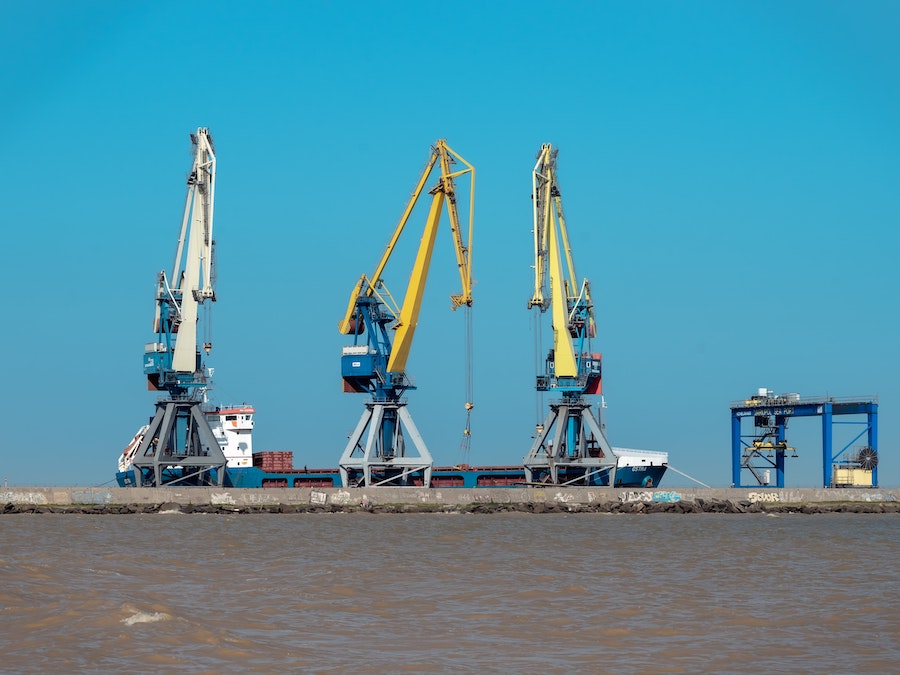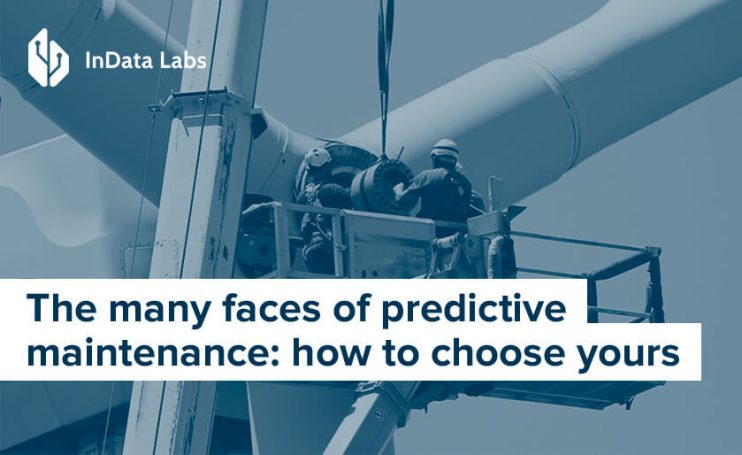Predictive maintenance systems and tech infrastructure have matured over recent years. It’s an axiom that hasn’t yet sunk into the minds of business owners. Love it or hate it, predictive maintenance is vital to keep your assets in an optimum operating state in the era of Industry 4.0.
Besides, the international market will equate to $12,3 billion by 2025. That’s the cost of acting proactively and reducing high maintenance costs. But before taking a step toward a data-driven strategy, you need to know how predictive maintenance and data analytics work. That’s why we’re here. Let’s look under the hood of this field and learn how to implement a predictive maintenance program in your organization.
What is predictive maintenance?
Predictive maintenance refers to the usage of augmented analytics and machine learning that monitors the state of machinery. Predictive maintenance systems assess potential malfunctions based on sensor data. This way, organizations can prevent costly problems with little to no disruption in daily operations.
Why has it become such a big deal today? Predictive maintenance techniques owe their popularity to the adoption of Artificial Intelligence and Big Data. The latter helps businesses accurately predict maintenance tasks thanks to Big Data.
In a broad sense, predictive maintenance tools fall into the category of predictive analytics. Also, this type of monitoring sometimes goes under the name of condition-based monitoring. It guzzles up IoT data to track the condition of your equipment.
What types of maintenance are there?
Predictive maintenance techniques go hand in hand with other types of maintenance.
Let’s have a look at the common maintenance used in organizations:
- Reactive – equipment is used until it fails,
- Preventive – scheduled maintenance that presupposes regular condition checks,
- Prescriptive – intelligent scheduling and planning of asset maintenance,
- Predictive (PdM), or condition monitoring – uses AI and ML algorithms to monitor the equipment during normal operation.
Condition monitoring is deemed the most effective among all since it eliminates the need for excessive frequent maintenance. It means that they may never attend to some components unless algorithms show the opposite.

Source: Unsplash
Now that we know the fundamentals, let’s have a look at how predictive maintenance and Machine Learning join forces.
How does it work?
The major selling point of predictive analytics solutions is that they schedule work based on the operating state of the machine. This factor allows industries to avoid emergency downtime and provide cost savings.
Three pillars lie at the heart of AI predictive maintenance services:
- Programmable logic controllers and sensors transmit real-time operation data and the current state of machinery.
- Internet-of-Things technology facilitates connections between hardware, software, and the cloud. This helps companies to gather data from multiple resources at the same time.
- AI predictive maintenance services scan processed data to perform failure prediction.
As we can see, the effective use of Big Data and data analytics algorithms thread the full life cycle of condition monitoring. Hence, Data Science is vital to analyze the gamut of data and act on the insights later.
Predictive data algorithms abide by predetermined rules coupled with machine learning techniques. This powerful combination allows technicians to compare the current behavior of a machine against its projected performance. Deviations are a sign of decline that might cause machine failure. To avoid unplanned downtimes, service technicians can intervene as needed or according to the schedule.
AI-powered algorithms can rely on equipment history, maintenance logs, and statistics. Here, your CMMS data can also provide important insights for data scientists.
5 real-life predictive maintenance examples
Predictive maintenance and data analytics can complement many businesses. However, there are a few domains for which the splurge for predictive analytics in business is most worthwhile.
Enhancing safety and transportation operations
Artificial Intelligence in transportation as well as the use of Big Data and analytics are the front and mind in the industry. Internet-connected sensors bolster the operation of transportation systems in the most efficient way. This results in increased safety and reduced maintenance costs. Thus, railway carriers embrace the opportunities Big Data entails. In the next 15 years, they’re likely to spend around $30 billion on IoT projects.

Source: Unsplash
Predictive maintenance tools help detect impending failures unseen by human vision. Real-time operational visibility translates into maximized asset life and reduced failure rates. For example, a British Network Rail company has reached the nPlan startup for ML potential. They’re deploying machine learning technology on rail projects by mid-2021. This added traction will enable the railway carrier to optimize its transportation network.
Power outage prevention
Power system assessments are usually the most regular inspections performed on equipment. Traditionally, electrical engineers analyze the power distribution systems and carry out a visual analysis. However, the electrical health of the electrical equipment can become safer with predictive performance metrics.
To prevent power outages, industries can tap into IoT data combined with AI algorithms. This way, major inconveniences become easier to detect. Also, this smart approach will inform when the power system is likely to crash down.
Oil and gas industry
According to a report, oil and gas companies face more than $40 million annually of financial repercussions. These losses are usually the result of unplanned downtime. In the worst-case scenario, companies lose up to $88 million. That’s why we see a rising trend of oil and gas companies turning to machine learning consulting companies.

Source: Unsplash
Big players like Shell, ExxonMobil and BP are pioneering in the adoption of artificial intelligence and Internet of Things (IoT) technologies. This revolution will prevent costly equipment glitches. Predictive maintenance software will also increase the output of oil and gas.
Predictive maintenance techniques in aviation
Data analytics for predictive maintenance also make a difference in the aircraft industry. Companies can maximize aircraft uptime and predict component failure. Thus, flight data recorders allow maintenance to be planned before the irregularity pops up. This leads to fewer unplanned removals and Aircraft-on-Ground (AOG).
Also, because of the pandemic, a growing number of aviation companies prioritize MRO (maintenance, repair, and overhaul). Thus, 66% of airline carriers deem predictive maintenance and machine learning as game-changers. Also, 54% of the airlines have turned to predictive analytics companies. So, a major overhaul of Maintenance Repair and Overhaul (MRO) systems is on the way.
Manufacturing monitoring
Industrial manufacturing companies have a lot of pre-existing equipment. Therefore, there’s a gnawing need for better monitoring and predictive technology. To make the best of established infrastructure, manufacturers cross-reference Big Data Analysis. The latter also comes as predictive maintenance techniques. By connecting devices, machines, and production lines to a single system, companies can gather valuable insights.
Also, infrared imagers help monitor specific factors, such as temperature and humidity. Vibration sensors scan equipment for degradations like pumps and motors. Altogether, this information can prevent overheating and failure. For example, Rolls-Royce is spearheading the use of IoT and Big Data devices. The company applies a service of engine rental. It includes predictive maintenance and Machine Learning to monitor the aging of safety-critical I&C components.

Source: Unsplash
As you can see, condition monitoring comes complete with AI algorithms. Let’s dwell on how intelligent techniques amplify Computerized Maintenance Management Systems.
AI in predictive maintenance: big player #1
You can address some types of predictive maintenance modeling with manual computations. But Artificial Intelligence can unravel the true value of data analytics for predictive maintenance. Smart technologies step in to analyze large volumes and diverse types of data from multiple sources. This allows companies to get a bird’s-eye view of asset operation and health.
These types of data can include the following sensor information:
- Temperature: measuring the amount of heat energy in a source and detecting temperature changes;
- Humidity: showing the concentration of water vapor, monitoring heating, air vents, and air-conditioning systems;
- Pressure: assessing water pressure in water systems for deviations or leaks;
- Vibration: screening for excess vibration in assets as a signal of failure.
Sensors come in different flavors. But unless you can put all this data to good use, they’re helpless.
Today, most companies apply a SCADA system for supervisory needs. It stands for ‘Supervisory Control And Data Acquisition. The system targets real-time data with the help of sensors. And it also monitors and controls the operations of a plant or equipment.
However, here’s why AI in predictive maintenance performs better than SCADA:
- This control system is complex. Hence, you need a team of skilled operators, analysts, and programmers to maintain and configure it.
- SCADA does not detect data irregularities.
- The system does not provide you with a sensor reading prediction.
- SCADA allows for local implementation only.
Hence, SCADA doesn’t make the most of Big Data. And that is why a growing number of companies are opting for Machine Learning instead. Machine learning can analyze data in real-time. It can automatically identify anomalies and find correlations. Therefore, there’s no need for manual intervention. Machine learning operates just by processing the data.

Source: Unsplash
Besides, ML algorithms automatically:
- Identifies potential failures;
- Recommends activities to reduce risk;
- Provides recommendations for the optimum maintenance schedules;
- Reduces downtime and maximizes uptime.
But mind that you need to hold enough data to train the model. In particular, you require:
- Error history – to provide failure patterns;
- Repair history – to inject error codes and parts order dates;
- Machine operating condition – as a valuable resource of data samples;
- Equipment metadata – basic input values such as start date and system location.
Data analytics: big player #2
We get to hear a lot about predictive analytics in sales and marketing. But its techniques underpin the adoption of PdM systems as well. Along with Machine Learning and IoT devices, predictive analytics are essential to model predictions. It is the practical result of Big Data and enabler of reliability techniques.
This field of science accumulates its power from an array of technologies. This includes Big Data, data mining, and ML algorithms. Within condition monitoring, it combs through current and historical data. Machine Learning classifiers then help detect trends and forecast asset failures.
Predictive maintenance has existed before. Specialists performed visual and instrumental inspections of equipment. After that, they decided based on their gut feeling and experience.
Today’s stage of PdM approach development is software, hardware-software, and data analytics. In real-time, the PdM system analyzes telemetry data using modern IT technologies. Then it finds hidden correlations between many measured parameters. It thus identifies anomalies and their causes as well as predicts the time to failure.

Source: Unsplash
Let’s have a look at how predictive analytics are practically implemented in maintenance.
Imagine, we have to predict energy loads to avoid machine failure. The step-by-step process will flow:
- Bring in data from various sources (open-source datasets, archives, IoT sensors).
- Process the data by eliminating missing data and anomalous points.
- Combine data sources (energy load, temperature, dew points).
- Train a predictive model using machine learning to calculate the load.
- Try the model against new data to access its viability.
- Embed the model into the in-plant system.
As we see, the predictive maintenance system is a patchwork of various disciplines. Let us share the gains this diversity gives you.
Benefits of predictive maintenance services
The examples below illustrate the added value of intelligent technologies. Let’s see what else reliability monitoring can bring to the table.
1.Panoramic picture of production performance
PdM systems tap into Big Data and simulate realistic operating scenarios. Manufacturers foresee non-obvious failures by applying Machine Learning algorithms. The latter analyzes past performance to prevent breakdowns and alert workers on them. This allows managers to make effective decisions based on historical data. As a result, financial planning becomes more transparent with accurate calculations.

Source: Unsplash
2.No human factor
The system orchestrates the data with no manual efforts. The model finds the right decisions and avoids errors. Therefore, duplicates, incorrect entries, or accidental editing are no longer a problem.
3.Cost-effectiveness
Being aware of the potential irregularities translates into economic benefits. PdM will prevent unnecessary maintenance costs and increase the lifetime of the machine. Thus, it will save you around 8% to 12% over reactive maintenance programs.
According to the U.S. Department of Energy, other add-ons include:
- Return on investment: 10 times
- Reduction in maintenance costs: 25% to 30%
- Elimination of breakdowns: 70% to 75%
- Reduction in downtime: 35% to 45%
- Increase in production: 20% to 25%.
4.Ideal maintenance timer
Thanks to this type of maintenance, employees can schedule maintenance time in the most cost-effective way. Thus, emergency downtime turns into shorter scheduled downtime. Therefore, the availability of the equipment increases.
Predictive maintenance challenges
No predictive solution is ideal. On the downside, predictive maintenance challenges include:
1.Upfront investment
Initially, you’ll need around $50K to jump into the program. This amount will cover a full-suite IoT system with sensors, transmission costs, and analysis. Also, in-plant personnel training will guzzle up a part of the budget.
2.Need for third-party expertise
Big Data is the future of predictive maintenance. But to effectively use it, you’ll require specialized expertise. Both technicians and analysts will make sure the data is interpreted correctly.
If we weigh the pros against the cons, it becomes clear PdM is worth the buck. Proactive alerting, early warning, and insight are priceless for production. Now let’s see how you can implement predictive maintenance in practice.
Tips to implement predictive maintenance
From identifying priority assets to connecting your IoT devices with an effective CMMS,
Bespoke deployment of a PdM system is critical to nailing a good ROI. But before the implementation process, estimates the budget and set Key Performance Indicators. After that, you can initiate the implementation regimen.
1.Develop a well-designed strategy
Start by identifying assets you need to IoTize. Machine failure history is the beacon for this choice. We recommend focusing on long-run assets since expendables are better off with standard maintenance.
If you’re doubting your choice, select a few assets to test the waters first.
2.Decide on the tools
Shortlist a few technologies that bode well for this kind of maintenance. The choice should rely on your unique business needs and industry. Thus, sensors vary from water to quality, and tools could be cloud-based and mobile to on-premise.
3.Assess the quality of data
Next, you need to re-visit the existing data. Equipment records can provide you with a range of actionable data for your pilot project. Machine behavior, on-site historical data, and manufacturing characteristics will shape your PdM model. Sometimes, you only need data on machine current, torque, or pressure to prevent failure.

Source: Unsplash
4.Identify failures
After that, you can analyze the frequency and severity of irregularities. The data will help you double-check on the assets you chose for the program. Narrow down your choice to the highest risk equipment.
5.Build an algorithm
As a next step, you need to train a predictive algorithm to make predictions. To do that, feed the data into a best-of-breed automated system. Your system will process both real-time IoT data and prognostic algorithms to alarm the failure.
For this step, you need to hire data scientists and embed an ML platform technology to automate algorithms. Each incident will enhance the algorithm to near-perfection.
6.Scale the PdM program
Instead of employing a team of data scientists, you can leverage cloud technologies. This way, your system will gather and crunch machine data on an enormous scale.
The output from the cloud-based analysis is available in interactive reports and dashboards. These will help the employees monitor machine performance and avoid downtime.
Top predictive maintenance tools in 2021
Companies can benefit from a great selection of tools. The latter speeds up their asset reliability and monitors conditions. Let us overview the most common options for measurements to get the PdM program started.
1.Infrared analyzer
These are multifunctional express analyzers that measure various parameters simultaneously. They do that by scanning the sample with near-infrared light. IR analyzers can both scan the sample and record the resulting spectrum. Thus, you can inject the results into your algorithm to spot the failure.
In production, IR analyzers can find hotspots that show deviations. For example, a failing bearing on a motor that has excess friction can be identified with AR analyzers.
2.Vibration analyzer
A vibration analyzer is a device for monitoring and registering vibration velocity and vibration acceleration. Vibration amplitude and frequency are also the common objects of analysis.
The analyzer stores and sends the information to the PdM system. Therefore, any change in vibration level is easily visible.
3.Ultrasonic analysis
Ultrasonic detection is by far the most reliable method in predictive maintenance. It is commonly used to identify the incipient bearing failure. Standalone ultrasound inspection programs can perform a wide range of analyses for reliability departments today.

Source: Unsplash
The applications vary from vibration and infrared imaging to air leaks. The low implementation costs also contribute to the popularity of such devices.
4.Oil analysis
Ineffective lubrication practices are attributed to surface degradation. Oil analyzers are among the most effective tools for monitoring oil contamination proactively. These analyzers monitor the oil health, contamination, and machine wear. They serve as a blood test for equipment.
5.Motor circuit analyzer
A motor circuit analyzer is a PdM tool that examines the electrical health of a motor. These tools measure the electrical properties of the windings. In this way, analyzers can identify faults by scanning electric motors’ components. Electrical signature analysis is the core component of this tool.
Bottom line
PdM systems seek to identify the future failure point of the asset so that employees can act proactively. Among other things, PdM technologies predict the best time for scheduled monitoring so that asset reliability stays high.
As we see from the article, Big Data, IoT technologies, and Data Science are the future of predictive maintenance. Enormous volumes of data uncover trends that are essential for peak operating abilities. Connected devices supply real-time data in real-time to prevent equipment failure. Finally, Machine Learning algorithms make sense of the data so that your assets enjoy a long and happy life.
Develop predictive maintenance solutions with InData Labs!
Contact us, in case you have questions about predictive maintenance project development.



